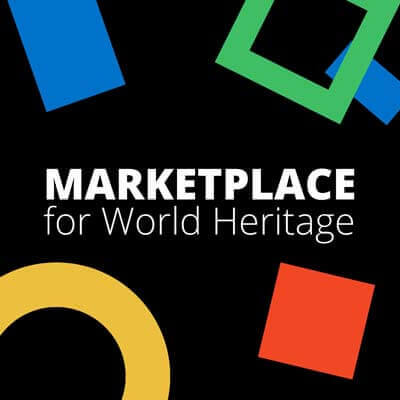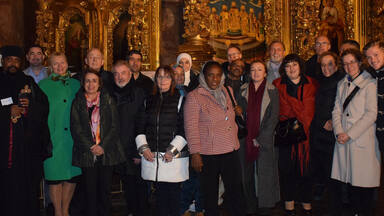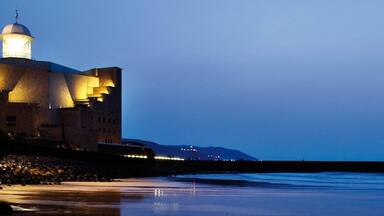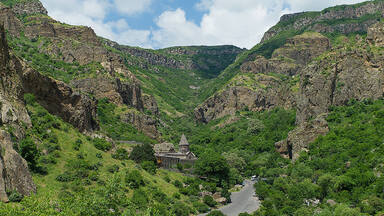Properties of Religious Interest – Sustainable Management [PRI-SM] Thematic Paper & General Guidance
The issue of the protection and management of properties of religious interest is increasingly prominent in contemporary conservation debates.
In today’s interconnected world grappling with serious socio-economic difficulties, ensuring constructive dialogue between the world’s cultures and religions ranks as one of the most pressing challenges on the international agenda.
World Heritage properties such as living religious and sacred sites, constitute, to this day, one of the largest thematic categories on the World Heritage List. In 2011, the World Heritage Committee requested the World Heritage Centre, in collaboration with the Advisory Bodies, to elaborate a thematic paper proposing to State Parties general guidance regarding the management of their cultural and natural heritage of religious interest, and in compliance with the national specificities (Decision 35 COM 5A).
This project aims to develop the thematic paper requested by the World Heritage Committee. It will also provide a platform for establishing cross-cutting approach for enhancing mutual respect, knowledge and understanding between communities that is in line with the UNESCO mandate for peace and dialogue.
Fund this project
US$ 250,000 per year
Duration
3 years
Beneficiary
Global
Category
Conservation ● Capacity Building
Document
Download project description

Context
The Initiative on Heritage of Religious Interest is managed by a Steering Group composed of officially designated representatives from the World Heritage Centre and the Advisory Bodies. The main international and regional institutions having the professional competency to contribute to the activities’ implementation are also involved.
The Steering Group is focusing on capacity-building activities and a case-study approach to identify the main challenges in the management of World Heritage cultural and natural sites of religious interest, as well as to collect inputs and relevant information necessary for the thematic paper. The Steering Group has developed a research programme, including data collection, case study analysis and survey activities, as well as a module for regional thematic consultations. Moreover, a module for Capacity-Building workshops for the representatives of religious communities and site managers in charge of World Heritage properties of religious interest, developed by ICCROM, was tested in Greece and the Russian Federation.
In February 2016, a cycle of Regional Thematic Consultations towards the elaboration of the above-mentioned thematic paper was launched at UNESCO Headquarters with the first meeting focused on South-Eastern and Mediterranean Europe. In May 2017, the International consultative workshop on conservation and management of World Heritage of religious interest focused on Asia-Pacific was held in Bangkok and Nakhon Phnom Province of Thailand. The World Heritage Committee, at its 40th session (Istanbul, 2016), reiterated its invitation to States Parties and other stakeholders to continue to support this Initiative.

Objectives
The overall objective is to elaborate a thematic paper proposing to the States Parties general guidance regarding management of cultural and natural heritage of religious interest.
More specifically, this activity aims:
- To enhance dialogue with national decision-makers, site managers and representatives of different religious communities from all over the world to allow for the exchange of views on best practices to improve the long-term management of properties of religious interest;
- To enhance the role that religious communities should play in the long-term management and preservation of World Heritage sites of religious interest;
- To identify the main challenges in the field of protection, conservation and integrated management of the World Heritage sites of religious interest.

Relevance
As the only intergovernmental organization with an explicit mandate in the field of culture, UNESCO strives to safeguard heritage in the broadest sense of the term, encompassing not only monuments and sites, but also traditions, lifestyles, values and belief systems.
By launching the Initiative on Heritage of Religious Interest, UNESCO plays a leading role in helping integrate a number of guiding principles into cultural policies at the local, national, regional and international levels so as to contribute to the rapprochement of cultures and harmonious relations among peoples.

Timeline
The project could be scheduled for a period of three years.
Phase I “Regional Thematic consultations”Reinforce a network of partners, including renowned researchers and experts, to seek views of spiritual traditions from elders and indigenous traditions, custodians, religious authorities, local spiritual communities and other relevant stakeholders that retain a close association with world natural and cultural heritage of religious interest; data collection and survey activities; organise thematic (national/regional) consultation workshops.
Phase II “Research, global thematic survey and data analysis”Collect and analyse data; carry out stakeholders consultation using case-study questionnaire; identify properties for in-depths research on a national, regional, global and transboundary basis, and consult the relevant national authorities and related religious or indigenous communities; define preliminary scope and content of the thematic paper and clarify key terminologies used.
Phase III “Consultation/production of thematic paper”Draft the text of the general guidance; consult with key stakeholders and World Heritage Committee members; collate and analyse responses to the consultation on the draft and incorporate them into the general guidance; select a sample of representative case studies - testing of general guidance; review and analyse results; conclusions: adjustments to be included; finalize the general guidance; establish a network to share experiences and implement the guidance; submit the thematic paper to the attention of the World Heritage Committee, in compliance with its decision.

Outcomes
& Beneficiaries
Outcomes
States Parties are provided with a general guidance in the form of a publication regarding the management of cultural and natural heritage of religious interest. Their capacities are reinforced in view of the management and preservation of this specific heritage.
Beneficiaries
- Responsible authorities: international, national, regional and local civil and religious authorities with responsibility for World Natural and Cultural Heritage of religious interest, custodians, World Heritage site managers, and other stakeholders concerned;
- Communities: local religious communities and councils of traditional authorities, concerned with or holding custodianship for World Natural and Cultural Heritage of religious interest;
- National and international agencies dealing with the wider field of protection, conservation and management of World Natural and Cultural sites of religious interest.
- National and International agencies and institutions and bodies involved in development project design and implementation.

Budget
An estimated extra-budgetary funding of US$ 750,000 (all phases) or US$ 250,000 (for each phase) is foreseen for the implementation of this project.
The support could be provided for the whole activity devised in three phases, or separately by phase. The World Heritage Centre reports to the World Heritage Committee on progress made.

Visibility
A communication & visibility plan will be developed in consultation with the donor(s) and will include (but not limited to) the options below:
|
Visibility material |
Placement / Event |
Outreach |
Audience |
|
|
Article on the World Heritage Centre’s website Homepage |
Logo |
WHC website: whc.unesco.org |
Public |
Statistics for 2016: 13,340,000 visits 9,735,000 unique visitors 41,650,000 pageviews |
|
Reports to the World Heritage Committee |
Logo |
World Heritage Committee session |
WH Committee members, Observers, NGOs, site-managers, press |
Approx. 2,000 participants from 193 countries |
|
Side-event |
Logo + speech |
|||
|
Article in the World Heritage Review |
Logo |
“World Heritage Review” Magazine and “World Heritage Information” |
Public |
Approx. 20,000 targeted subscribers |

Contact
Anna Sidorenko
Coordinator
Thematic Initiative on Heritage of Religious Interest
World Heritage Centre
a.sidorenko@unesco.org
Decisions / Resolutions (1)
The World Heritage Committee,
1. Having examined Documents WHC-11/35.COM/5A and WHC-11/35.COM/INF.5A,
2. Recalling Decision 34 COM 5A adopted at its 34th session (Brasilia, 2010),
3. Takes note of the activities undertaken and of the partnerships established by the World Heritage Centre;
4. Also takes note with appreciation of the concrete contribution of the States Parties and all partners who, through their financial and/or technical support, contributed to the efforts to implement the Convention reported in the document WHC-11/35.COM/5A;
5. Reminds the World Heritage Centre of the necessity to elaborate, at each session of the World Heritage Committee, a report on envisaged and concluded partnerships and requests that it be completed with an evaluation of these partnerships based on relevant tools, in particular on the use of the emblem and the benefits received, in order to ensure strict compliance with the Convention's principles and objectives;
6. Requests the World Heritage Centre to continue improving its report by adding to the Periodic Reports:
a) a general comment on progress made and gaps identified at global and regional levels, at thematic level, at the level of different financing sources, and at the level of financial partners or cooperation with States Parties, other Conventions, civil society and the private sector,
b) a comprehensive inventory of pending decisions and the foreseen dates of implementation,
c) a provisional priority activities plan for the following year including the formulation of objectives and expected results, as well as indications on related resources (human and financial);
7. Takes note of the recommendations of the International Seminar on the Role of Religious Communities in the Management of World Heritage properties, organized in Kiev, Ukraine, in November 2010, and requests the World Heritage Centre, in collaboration with the Advisory Bodies, to elaborate a thematic paper proposing to States Parties general guidance regarding the management of their cultural and natural heritage of religious interest, and in compliance with the national specificities, inviting States Parties to provide voluntary contributions to this end;
8. Requests the Director of the World Heritage Centre to continue informing it on an annual basis on:
a) authorization granted by the World Heritage Centre on the use of the World Heritage emblem,
b) envisaged and concluded partnerships, with indications on the modalities and terms of such agreements,
and invites the Director to submit a draft of the new PACT Initiative Strategy, taking into account the results of the evaluation of the External Auditor on the PACT initiative for examination at its next session, one of its major objectives being the increase of resources to the World Heritage Fund to the benefit of International Assistance.
Read more about the decision





